Photo: from left to right, Eric Ta and Jared Kolb from Green Communities Canada with Energy Advisor Gabriel Nadeau at The Gathering.
Green Communities Canada was privileged to attend The Gathering—a three-day event hosted by Indigenous Clean Energy November 27-29, 2024, in partnership with The Globe and Mail. The event brought together indigenous leaders with representatives from companies, utilities, and governments involved in the clean and just energy transition to forge meaningful partnerships and accelerate ethically grounded pathways forward.
Key take-aways:
- In 2023, clean energy projects added approximately $320 billion USD ($450 billion CAD) to the world economy;
- Between 2000 and 2020, Indigenous participation in clean energy has significantly shifted from exclusively hydroelectric projects to a diverse palette of hydro, bioenergy, solar, and wind;
- In 2020, Indigenous participation in clean energy projects focused mostly on solar and wind;
- Sessions at the Gathering were quickly filled to capacity, evidence of the popularity and salience of this event and the topics and issues being discussed;
- Energy storage, home energy efficiency, and advanced grid technologies are also getting increased interest and investment;
- In BC, communities are leading the charge with nearly 40% of all medium-to-large clean energy projects from the period between 2000 to 2023 being Indigenous-owned; Ontario trails 11% behind while Quebec trails nearly 30% behind;
- With progress towards electrification, electricity demand is growing and it is increasingly essential that we focus on demand-side management, energy efficiency, and upgrades to the grid and storage solutions as well as generating additional supply from renewables;
- Higher levels of community ownership of renewable energy projects contribute to higher levels of well-being in Indigenous communities as revenues from projects are reinvested back into the community;
- Indigenous communities benefit from owning and leading renewable energy projects like wind and solar because these have fewer negative impacts on Indigenous communities than has historically been the case with fossil fuel projects;
- An emerging priority is the development of a fund for deep energy retrofits of existing Indigenous housing which has typically been built inadequately and, sometimes, incompletely due to an acute housing crisis that prioritized speed;
- Priority for building funding and training for increasing clean energy expertise in Indigenous communities and among Indigenous youth, women, Two-spirit folks, and men.
Starting in a Good Way
The morning of the first full day of the event, as the eager attendees buzzed in conversation, the warm and playful voice of the Master of Ceremonies—Gary Smith, from Nagaajiwanaang First Nation and a background as a trauma-based-healing Aftercare Clinician—eventually cast a calm over the crowd. He introduced the community where he was from, and the significance of the placename meaning “at the place where the current is obstructed”. He went on to explain that the land upon which the meeting was taking place that day was known as “the place of the (bald) eagle” and was named so for the largest clan (dodem) of the area—in the case of the GTA, that would be the Eagle Clan. Two other major dodems, found further north, are the Moose Clan and the Bear Clan who thus lend their names to the land.
Gary introduced Elder Daniel Secord from the Nishnaabek Mizizaagiik Nation, of the Mukwa dodem (Bear clan), who lives in the Mississaugas of the Credit First Nation with his children. Elder Daniel led the room in traditional prayer and then in a traditional drum ceremony. Those in the crowd who were able to stood to honour the sanctity of the ceremony and pay respect to the drummers and singers as the rhythmic reverberations and singing brought together heartbeats and minds.
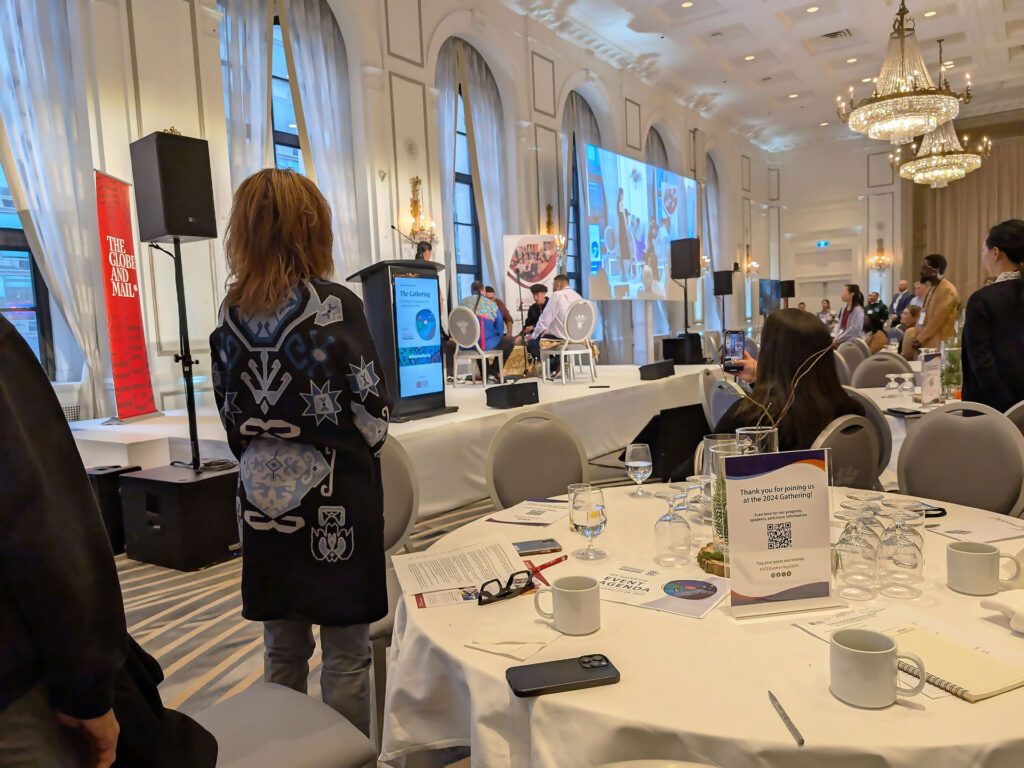
Attendees, who are able, stand in respect to the drummers and the drum ceremony.
Next, Ogiimaakwe (Chief) Claire Sault of Mississaugas of the Credit First Nation addressed the crowd and welcomed attendees to their traditional territory and acknowledged the land where this meeting was taking place. She and Andrew Saunders, the President and CEO of The Globe and Mail, made welcoming remarks to the gathering.
The Landscape of Indigenous Participation in Clean Energy
Gary then welcomed James Jenkins, Executive Director of Indigenous Clean Energy, to present data insights on an Indigenous-led clean energy future in Canada.
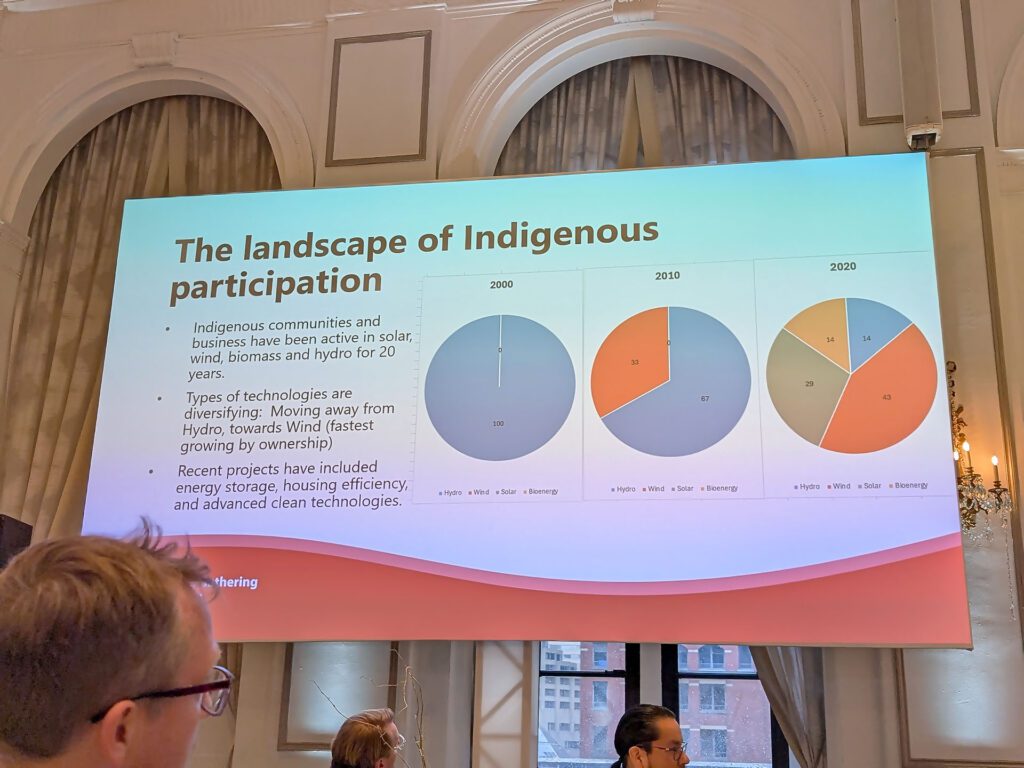
Above: the slide shows three graphs showing changes in the types of energy projects Indigenous communities were involved in 2000, 2010, and 2020. The first pie chart shows that, in 2000, 100% of the projects were in hydroelectricity. A decade later, wind energy accounted for a third of the share of projects; a decade after that, in 2020, wind accounted for 43% while hydro fell to 14%—on par with bioenergy projects and behind the 29% share of solar energy projects.
James duly noted that energy efficiency and demand-side management should not be overshadowed by solar and wind. Reducing energy consumption is the most cost-effective tool in the clean energy belt—the cleanest and cheapest unit of energy is the one that is saved and not used.
James spoke on the Canadian landscape of Indigenous participation in clean energy projects. The graph showed that nearly 40% of all medium-to-large clean energy projects completed between 2000 and 2023 in BC are Indigenous-owned. In Ontario, that’s only slightly over and quarter of projects in the same time frame and then substantially less in Quebec and other provinces/territories.
James noted that electrification was progressing at a steady rate and that grid expansion, upgrades, and automation would be important factors in managing the growth of demand for electricity across jurisdictions. Another core message is that Indigenous involvement and ownership is quickly growing and will be essential to an electrified energy future.
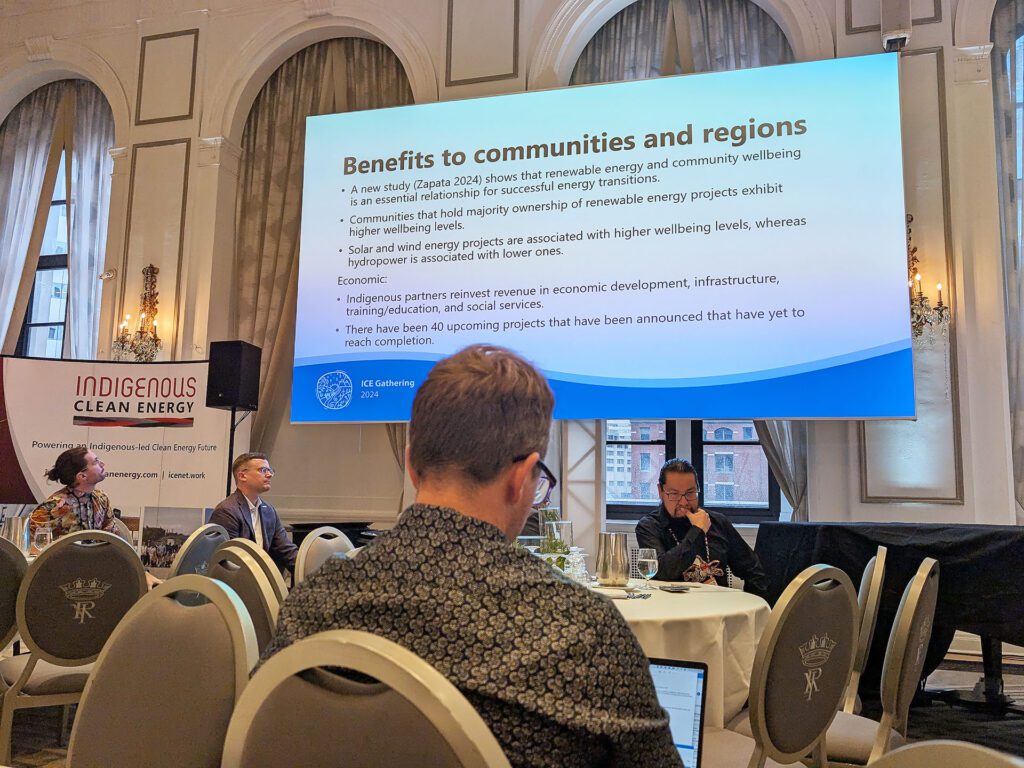
James wrapped up by referencing a 2024 study showing that communities holding majority-ownership of wind and solar energy projects experience higher wellbeing than communities that do not hold ownership or are involved instead in hydropower (and, likely, even lower wellbeing for those involved in fossil fuels).
Relationships and Consultation
After James’ presentation, National Chief Cindy Woodhouse Nepinak of the Assembly of First Nations spoke to the assemblage of attendees representing their communities, governments, and industries about the importance of rebuilding relationships that are mutually beneficial.
“First Nations play a pivotal role in driving climate action and ensuring the success of Canada’s clean energy future,” Chief Woodhouse Nepinak stated. “First Nations must be at the table, not just on the menu.”
The first panel discussion centered around capital ‘C’ Consultation versus lowercase ‘c’ consultation as the way forward, involving Indigenous communities early in the process rather than as an unceremonious afterthought. Historically, energy projects in Canada have largely moved ahead without meaningful Indigenous consultation.
Networking and Cultural Connections
During the lunch break, Green Communities Canada met with one of their energy advisors, Gabriel Nadeau, who had recently worked with the indigenous community in the hamlet of Fort Chipewyan, as well as with Calvin Waquan from Askiy Energy who is leading that work in his community.
A room was made available for attendees—indigenous and non-indigenous, alike—to be introduced to and access indigenous medicines and knowledge. Each visitor was given the opportunity to smudge with the smoke of sacred sage and sweetgrass to cleanse body, mind, and spirit. The participants included three Kichwa attendees from Amazonia and their Spanish-English translators, who learned from Anishnaabe Knowledge Keeper Roy Frederick Tom about Anishnaabemowin words ranging from colours to animals.
Health and Housing
The final panel of the night discussed energy and its intrinsic impacts on climate and health. Sarain Fox, an Anishinaabekwe artist and activist from Batchewana First Nation in northern Ontario, moderated the panel leading the traditional introductions of each panelist. Janna Wale, a Gitxsan and Cree-Métis woman from Gitanmaax First Nation in northern British Columbia who works as the Indigenous Research and Participation Lead at the Pacific Institute for Climate Solutions, noted that housing needs are dire in many Indigenous communities where many houses are inadequately constructed or incomplete leading to moisture, mould, and health issues.
Minor Chief Steven Crowchild of the Tsuut’ina Nation, which Calgary is located next to, agreed with Janna that many members of Indigenous communities are unable to find housing in their communities and are forced to find housing elsewhere.
Margaret Pfoh, CEO of the Aboriginal Housing Management Association and Tsimshian woman from the Lax Kw’alaams First Nation, referenced Maslow’s hierarchy of needs and how, “without healthy housing, we can’t take care of our children and elders.” Margaret mentioned how conventional energy projects brought man camps that were well-known dangers to indigenous communities. She added that communities switching from diesel to solar and wind to address energy poverty and cost-of-living noted native fauna and flora returning to the land as the oppressive noise and acrid fumes left their community.
To close out the evening, The Globe and Mail introduced Melina Laboucan-Massimo. Laboucan-Massimo is from the Lubicon Cree Nation in northern Alberta and is the Founder of Sacred Earth Solar and Co-founder of Indigenous Climate Action. Laboucan-Massimo spoke about the impacts of the fossil fuel industry on the health of her entire community’s air, waters, lands, and bodies. She fought back tears after bringing up the topic of the Alberta Government’s moratorium on new solar projects and the devastating resulting loss of jobs and loss of billions of dollars of clean energy investments. Laboucan-Massimo noted that it was important to hold on to hope and not be dissuaded by the negative news, offering that the positive stories in the documentary series Power to the People are an inspiring and healing alternative.
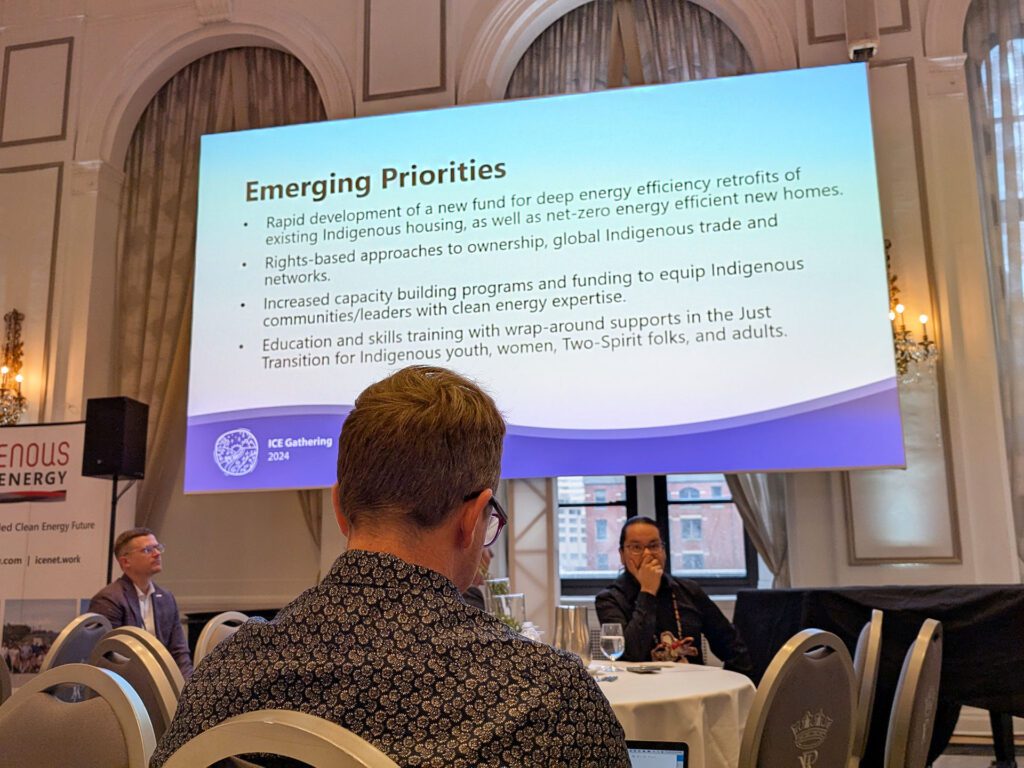
In 2023, clean energy added approximately $320 billion USD ($450 billion CAD) to the world economy according to the International Energy Agency. That is a 10 per cent growth in GDP in one year. Clean energy capacity and investments will continue to become ever-larger drivers of economic development, job creation, and net-zero progress. Canada aims to chart a new path to a prosperous and shared future that reconciles past exploitative relationships with Indigenous Peoples. Equitable partnerships that promote and uplift Indigenous leadership in clean energy initiatives are essential. Recognizing past wrongs, making right the injustices, and committing to promises to never again repeat past crimes upon others is the only path forward.
Further reading:
Bohdana Innes: Healing Our Housing
– https://oaa.on.ca/whats-on/conference/2024-conference-program/2024-conference-program-detail/healing-our-home-moose-cree-housing-prototype
Energy Efficiency: Bringing it Home
– https://indigenouscleanenergy.com/our-programs/bringing-it-home/
– https://assets.circle.so/sef2yhs0cny36m9288e7zklo9o8c
Grace Nakimyak
– https://cabinradio.ca/204328/news/beaufort-delta/paulatuk/ottawa-commits-500k-to-paulatuk-wind-project/
Chief Kele Antoine
– Łı́ı́dlı̨ı̨ Kų́ę́ First Nation – On-the-land Camp Solar and Wind Project ($77,105)
– https://www.nationalobserver.com/2024/01/16/news/empowering-communities-and-fossil-fuel-workers-go-green
Angus James Capot-Blanc (Ancho Dene Koe First Nation)
– https://cabinradio.ca/211886/news/politics/ottawa-commits-2m-to-fort-liard-geothermal-project/
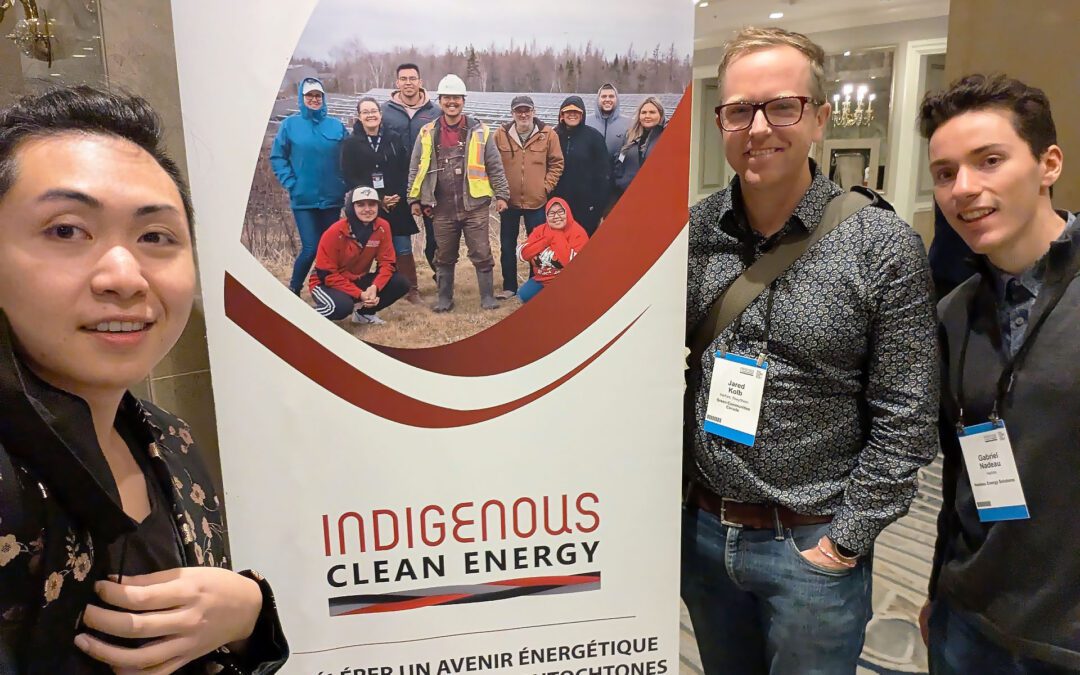
Recent Comments